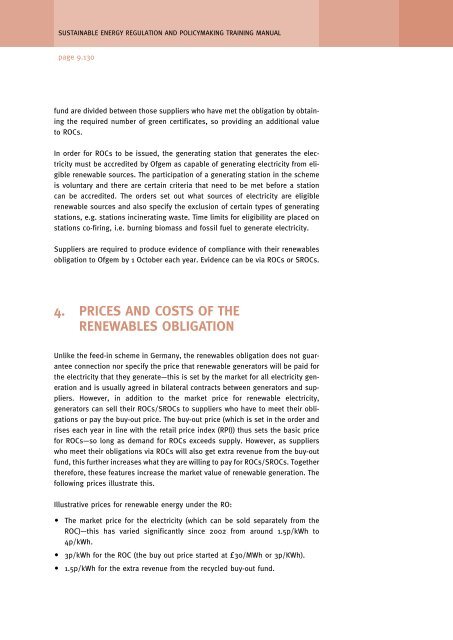Regulatory and policy options to encourage development of ...
Regulatory and policy options to encourage development of ...
Regulatory and policy options to encourage development of ...
- No tags were found...
Create successful ePaper yourself
Turn your PDF publications into a flip-book with our unique Google optimized e-Paper software.
SUSTAINABLE ENERGY REGULATION AND POLICYMAKING TRAINING MANUALpage 9.130fund are divided between those suppliers who have met the obligation by obtainingthe required number <strong>of</strong> green certificates, so providing an additional value<strong>to</strong> ROCs.In order for ROCs <strong>to</strong> be issued, the generating station that generates the electricitymust be accredited by Ofgem as capable <strong>of</strong> generating electricity from eligiblerenewable sources. The participation <strong>of</strong> a generating station in the schemeis voluntary <strong>and</strong> there are certain criteria that need <strong>to</strong> be met before a stationcan be accredited. The orders set out what sources <strong>of</strong> electricity are eligiblerenewable sources <strong>and</strong> also specify the exclusion <strong>of</strong> certain types <strong>of</strong> generatingstations, e.g. stations incinerating waste. Time limits for eligibility are placed onstations co-firing, i.e. burning biomass <strong>and</strong> fossil fuel <strong>to</strong> generate electricity.Suppliers are required <strong>to</strong> produce evidence <strong>of</strong> compliance with their renewablesobligation <strong>to</strong> Ofgem by 1 Oc<strong>to</strong>ber each year. Evidence can be via ROCs or SROCs.4. PRICES AND COSTS OF THERENEWABLES OBLIGATIONUnlike the feed-in scheme in Germany, the renewables obligation does not guaranteeconnection nor specify the price that renewable genera<strong>to</strong>rs will be paid forthe electricity that they generate—this is set by the market for all electricity generation<strong>and</strong> is usually agreed in bilateral contracts between genera<strong>to</strong>rs <strong>and</strong> suppliers.However, in addition <strong>to</strong> the market price for renewable electricity,genera<strong>to</strong>rs can sell their ROCs/SROCs <strong>to</strong> suppliers who have <strong>to</strong> meet their obligationsor pay the buy-out price. The buy-out price (which is set in the order <strong>and</strong>rises each year in line with the retail price index (RPI)) thus sets the basic pricefor ROCs—so long as dem<strong>and</strong> for ROCs exceeds supply. However, as supplierswho meet their obligations via ROCs will also get extra revenue from the buy-outfund, this further increases what they are willing <strong>to</strong> pay for ROCs/SROCs. Togethertherefore, these features increase the market value <strong>of</strong> renewable generation. Thefollowing prices illustrate this.Illustrative prices for renewable energy under the RO: The market price for the electricity (which can be sold separately from theROC)—this has varied significantly since 2002 from around 1.5p/kWh <strong>to</strong>4p/kWh. 3p/kWh for the ROC (the buy out price started at £30/MWh or 3p/KWh). 1.5p/kWh for the extra revenue from the recycled buy-out fund.










